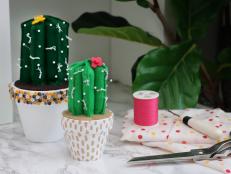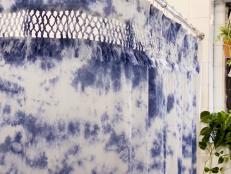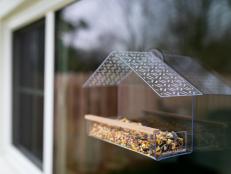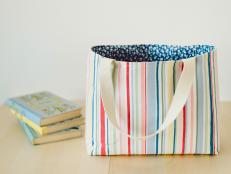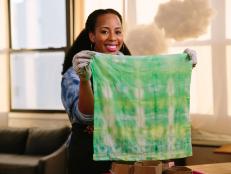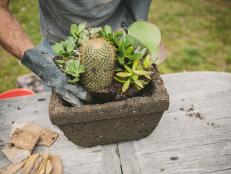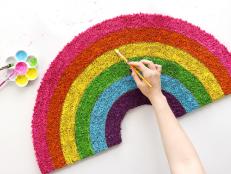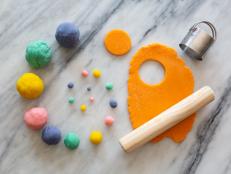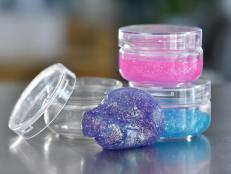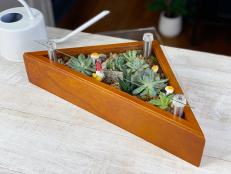How to Start Using Your Cutting Machine
If you’re afraid to take your new cutting machine out of the box, you’re not alone. Even Dennis Setteducati and Andrew Boza — The Crafty Lumberjacks — were afraid to use their new machine at first. Learn how to become a cutting machine pro with our beginner's guide for Cricut, Silhouette and other popular brands, then get step-by-step tutorials for making a sticker and an iron-on.

Anders Krusberg
It’s there, it’s heavy, and it’s still in its box. You’re a bit afraid to bother it, lest you make it angry, right? What will happen when you finally awaken the beast?
Creative doors will be thrown open, that’s what.
Cutting machines can be intimidating to beginners, but the Crafty Lumberjacks and HGTV have everything you need to start using your cutting machine for decals, iron-on designs and more.

Anders Krusberg
What Is a Cutting Machine?
Cutting machines cut designs into a variety of materials. Think of it like an old school die cutter from your school library, but instead of being stuck with a single-size cutting die, you can create your own designs using your smartphone, computer, or tablet in any size and then use your cutting machine to create stickers, decals, iron-on designs and more.
How to Make a Custom Sticker With Cricut Maker
Decorate your car, computer, phone case, walls and any other smooth surface with vinyl stickers designed by you and the Cricut Maker.
What Can I Cut With a Cutting Machine?
That largely depends on the kind of cutting machine you use, but the most common materials used are vinyl (both adhesive and heat-transfer varieties) and all manner of paper. Some machines can cut thinner pieces of wood, cardboard or even fabric. There are hundreds of materials that you can use with your cutting machine depending on your project and the blades you have available.
What Terms Should I Know?
- Burnish: Burnishing is when you run a scraper across transfer tape while preparing to place your vinyl decal. Burnishing happens at two times, when you apply transfer tape to the decal and when you place the decal on its final surface before peeling the transfer tape away.
- Brayer: A brayer is a roller you can use to ensure vinyl adheres to the cutting mat.
- HTV: Heat transfer vinyl (HTV) sticks to its destination surface by applying heat and pressure to activate the adhesive on the back.
- Heat Press: A heat press provides a solid, evenly heated surface to apply HTV to the destination surface. Heat presses allow you to set the exact temperature, which is important for different kinds of HTV. You can use an iron if you don't have a heat press.
- Weeding: Weeding is the step that occurs after your cutting machine has cut your design out. Using a pick and/or tweezers, remove the excess vinyl from around your design.
- Vinyl: Vinyl is used to make decals with a cutting machine.
- Transfer Tape: Adhesive vinyl is used to transfer adhesive vinyl decals to the destination surface.
What Kinds of Cutting Machines Are There?
The most well-known cutting machine belongs to Cricut. Cricut’s latest generation of cutting machines includes the Explore 3, Maker 3 and Cricut Joy.
Cricut Maker cuts over 300 materials, from card stock to leather. This bundle Cricut Maker plus tools and materials will get you crafting right away.
Why the Cricut Joy Is the Perfect Machine for Experienced Artisans and Novice Crafters
Want to get in on the craft cutting craze but not interested in dropping a lot of money? Keep reading. You’ll jump for (Cricut) joy.
Silhouette is another cutting machine company. Their Cameo line offers three different widths of available cutting surfaces while their smaller Portrait model is smaller and more compact. Silhouette markets the Portrait as being great for crafting on the go.
Brother (also the maker of printers, sewing machines and scanners) has its own line of cutting machines branded as ScanNCut. ScanNCut machines don’t have a separate software application — everything you need to get crafting is accessed through a small screen on the machine.
How Does Cutting Machine Software Work?
Cricut and Silhouette both have their own proprietary design software that allows you to select projects from a large catalog or make your own designs using text and images. The design software is similar to desktop publishing software, but you are creating designs that can be cut into a variety of materials for various uses. See more about the software in The Complete Cricut Machine Handbook: A Beginner’s Guide to Creative Crafting with Vinyl, Paper, Infusible Ink and More! by Angie Holden.

Anders Krusberg
What Tools Do I Need For My Cutting Machine?
Your cutting machine will come with a few accessories, but you will probably find you want to buy a set of tools that include a brayer, tweezers, scraper, scissors and various picks to help you weed your designs.

Anders Krusberg
Cricut also offers several peripheral devices for your crafting adventure such as the heat press, hat press, mug press, brightpad and floor lamp.
Make Custom Coffee Mugs in Minutes With the New Cricut Mug Press
From the Cricut family of products comes a new gadget I was initially skeptical of: the Cricut Mug Press.
Crafts to Make With Your Cutting Machine
The full creative power of a cutting machine is seemingly endless, but you should get comfortable with the basic cutting machine projects before you try layered designs, massive wall murals or complicated birthday cards.
Follow along with the Crafty Lumberjacks as they create an adhesive vinyl sticker and a heat transfer vinyl logo for a canvas bag.

Anders Krusberg
How to Make an Adhesive Vinyl Decal With a Cricut
Materials + Tools
- Cricut cutting machine
- computer, tablet or smartphone
- cricut adhesive mat
- vinyl
- HTV
- a flat, blank surface for vinyl project
- a fabric blank for HTV
- transfer tape
- tool set
- heat press
- heat press mat
1. Design and Size Project
Find a simple premade image on Design Space (Cricut’s design software). Measure the base material and size the image accordingly (Images 1 + 2). Tip: The base material should be something smooth and non-porous.

Anders Krusberg

Anders Krusberg
2. Prep Vinyl
Cut your vinyl slightly bigger than the image and place it in the left hand corner of the adhesive mat. The mat will have a grid, making it easier to match up with Design Space (Image 1). Use the roller tool to roll over the surface area of the vinyl with moderate pressure; make sure to roll over the edges well, this will help ensure you have the best cut (Image 2).

Anders Krusberg

Anders Krusberg
3. Cut Out Image and Unload
On Design Space, press “Make It” and follow the prompts on the screen to select the material you’re cutting (Image 1 + 2). Load the mat into the machine and press the blinking light (Image 3). Every brand of cutting machine will lead you through these steps. Press go and watch the machine do its magic! (Image 4) Once the machine is done cutting, take off the vinyl from the mat. The best way to do this is to turn the mat over and peel the mat off the vinyl (Image 5). This will prevent the vinyl from curling.

Anders Krusberg

Anders Krusberg

Anders Krusberg

Anders Krusberg

Anders Krusberg
4. Weed Vinyl
Weeding is the process of removing unwanted material you do not want on your project. A weeding tool looks like a hook or a dentist's pick. Dig the point of the hook into the piece of excess vinyl and lift it away. Continue this process until you have the unwanted vinyl weeded and you’re left with your cut image (Image 1-3).

Anders Krusberg

Anders Krusberg

Anders Krusberg
5. Add Transfer Tape
Vinyl is like a sticker, but instead of peeling it and placing it on the base materials, use transfer tape. Transfer tape will make it easier to position the image onto the base material. Cut a piece of transfer tape slightly larger than the image. Peel off the backing and place the transfer tape sticky side down on top of the vinyl image (Image 1 + 2). Burnish the transfer tape well using the scraper tool, turn the vinyl over and repeat on the backside (Image 3). Slowly peel the vinyl liner away from the transfer tape and design at an angle (Image 4 + 5). Tip: If the vinyl doesn’t separate from the liner, burnish again and peel.

Anders Krusberg

Anders Krusberg

Anders Krusberg

Anders Krusberg

Anders Krusberg
6. Apply Vinyl to Surface
Clean your base material with an alcohol wipe (Image 1). Once dry, hold the transfer tape with two hands with the adhesive side facing the base material. Center it as best as you can and attach the center of the design on the surface (Image 2). Press your finger onto the transfer tape, smoothing out the vinyl onto the base material. Burnish the transfer tape and then slowly peel it off, revealing your image (Image 3-5).

Anders Krusberg

Anders Krusberg

Anders Krusberg

Anders Krusberg

Anders Krusberg
How to Make a Heat Transfer Vinyl Decal With a Cricut
Materials + Tools
- Cricut cutting machine
- computer, tablet or smartphone
- cricut adhesive mat
- vinyl
- HTV
- a flat, blank surface for vinyl project
- a fabric blank for HTV
- transfer tape
- tool set
- heat press
- heat press mat
HTV is similar to vinyl, but instead of having a sticker-like adhesive, HTV backing activates with heat and pressure.

Anders Krusberg
1. Design and Cut Project
Start by designing your project or picking a premade image on Design Space. Once finished, click “Mirror” — this will flip your design. The machine will cut your project face down, however you will apply it to your material face up, so it will be correct (Image 1 + 2). Place the cut piece of HTV onto the mat shiny side down, matte side facing up (Image 3 + 4). Follow the prompts and let the machine do it’s thing (Image 5).

Anders Krusberg

Anders Krusberg

Anders Krusberg

Anders Krusberg

Anders Krusberg
2. Weed HTV
Unload the mat from the machine, flip it over and remove the HTV (Image 1). Weed the unwanted pieces of HTV just as you would adhesive vinyl (Image 2 + 3). Continue this process until you have the unwanted HTV weeded and you’re left with your cut image (Image 4).

Anders Krusberg

Anders Krusberg

Anders Krusberg

Anders Krusberg
3. Prep Material
Place your material onto a heat press mat. If your material has two layers, like a shirt or a bag, sandwich a piece of card stock between the two layers to prevent them sticking together. Use a lint roller over the top of your material to remove any lint, dust or hair (Image 1).

Anders Krusberg
4. Apply the HTV
Instead of transfer tape, use a heat press to apply your HTV. A heat press is basically a fancy iron that allows you to set the exact temperature and time you need for the most successful transfer on your surface (Image 1). No matter what brand you are using, it will come with a guide that will ask you what type of HTV and base material you are using to give you the best results. Place the heat press onto your surface and follow the guide (Image 2-4).

Anders Krusberg

Anders Krusberg

Anders Krusberg

Anders Krusberg
5. Remove Backing
Once cool to the touch, carefully and slowly remove the backing (Image 1). If your HTV is not fully applied, stop pulling off the backing and press the heat press back on for a few seconds.

Anders Krusberg

Anders Krusberg
6. Resist the Urge to Cover Everything You Own in Vinyl
Actually, don't resist the urge because it's really fun to label things, make stickers for your car and personalize gifts.

Anders Krusberg












